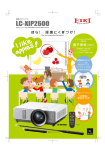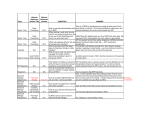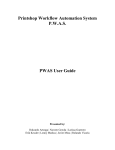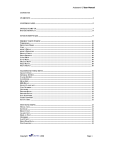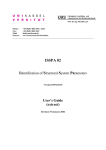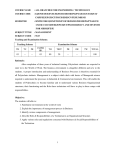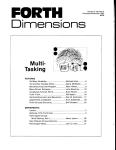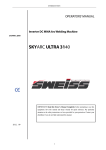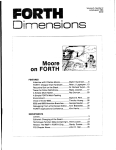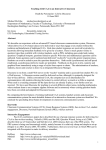Download Chapter 3
Transcript
3 IN THE CLASSROOM 3.1 INTRODUCTION One of the most important findings of educational research is that physics Active involvement is imstudents need to be actively engaged with the material if they are to develop a portant! flexible understanding of the ideas. It is also well-established (as previously discussed) that (1) lectures are not generally the best tool for conveying detailed information, (2) a student’s attention span during a lecture is about 15 minutes, and (3) lectures become more effective if broken up by other activities. In a small class or laboratory section, it is not difficult to engage students in Smaller class sizes help! active learning, but this is not so easy in a large class. If it is at all possible, I strongly urge you to break up large classes into sections of 30 students or less. The idea that physics can be effectively taught in huge lecture sections presupposes that teaching physics is primarily a process of conveying facts from teacher to student: we all now know that this is an inadequate model for the real process of learning physics. Reducing class size may be one of the most effective modifications that an institution can make to improve instruction in introductory physics. (Why is it that math departments all over the country have successfully convinced administrators that calculus cannot effectively be taught in large sections but physics departments have trouble making the same case about introductory physics?) Unfortunately, large classes are a fact of life at most institutions. The purpose of this chapter is to explore how even larger classes can be made into active learning environments using some of the tools provided in the Six Ideas text. 3.2 THE PRESSURE TO LECTURE One of the most surprising things that we found in early trials of the course is that even those of us who were most convinced of the importance and efficacy of active learning found ourselves drifting back into lecturing more and more. The basic problem is that lecturing feels so good! Lecturing for many of us is a satisfying and well-established habit. When I am lecturing, I feel like I am in control of the class. The class seems orderly instead of chaotic. When I have stated the ideas of the chapter clearly and precisely, I feel like they must have been learned and I have done my job. On the other hand, during a class devoted more to active learning, the atmosphere is often chaotic. The real learning is taking place behind the scenes where it is not easy to see. At the end of such a class, I sometimes worry that nothing useful has happened (and students do, too). When students have difficulty, it is easy to imagine that telling them how to think will straighten everything out. Moreover, students like me to lecture because active learning involves real thinking early in the morning and is therefore painful: listening to a lecture is more relaxing and more like entertainment. Moreover, many of them really think that it is your job to convey to them the truth about physics, and can be restive, angry, or even resistant when you don’t. The trick is to remind yourself continually that your feeling that students really absorb what you say in an extended lecture is an illusion. Students can no more learn to think like physicists simply by listening to you lecture than someone can become a pianist simply by listening to great pianists. This doesn’t mean that it is not helpful sometimes to listen to great pianists if you want to become a pianist. It just means that listening is no replacement for personal practice. By the same token, occasional short lectures can be an import- Why lecturing feels so good How to resist the temptation 24 3: In the Classroom ant and helpful part of a class session. I find I need to keep reminding myself that students are really learning when they are trying to do it themselves, and that even if I cannot see it, learning really is happening. Indeed, if your child’s piano teacher were to spend the whole lesson-time lecturing and playing the piano to your child, or your child’s soccer coach were to spend every practice talking to your child and demonstrating how to kick the ball, you would be outraged. We know that in these contexts, such instruction is not effective. The trick is to understand in your heart as well as your mind that teaching physics is really much the same kind of process. Your students may need to be educated in this regard as well. Many of them will understand the sports or music metaphors that I have just described. It might also help to hand out a subset of the bibliography in chapter 1, and let them read for themselves the evidence that interactive classes do pay off. 3.3 A guide to this chapter WHAT YOU CAN DO BESIDES LECTURE There are many things that you can do with class time that are more effective than delivering an extended lecture. You can: 1. 2. 3. 4. 5. 6. 7. 8. 9. Do two-minute problems (see section 3.4) Have students work problems in groups (see sections 3.5 and 3.11). Do demonstrations (see section 3.6) Have students do small-scale experiments (see section 3.6) Show videos or computer simulations (see section 3.7) Answer questions (see section 3.8) Engage in discussion (see section 3.9) Work an example problem (see section 3.9) Deliver short lectures (punctuated by other activities: see section 3.10). Section 3.12 reflects briefly on the process of preparing for class. 3.4 USING THE TWO-MINUTE PROBLEMS How to use the two-minute problems Beneficial features of this process The main active-learning process supported by the text is doing two-minute problems. Every chapter in the text has between six and twelve two-minute problems. These problems (1) are primarily qualitative in character, (2) often challenge common preconceptions or misconceptions, (3) can (usually) be answered within a few minutes, and (4) have associated possible answers presented in multiple-choice format. You can use these problems as follows. Pose one of the problems to your students and instruct them to collaborate with one or two neighbors to determine the answer. Then let them work for roughly two minutes. When the time is up, call for answers. Each group then holds up a sign displaying their chosen answer. You scan the signs and summarize the results verbally for the class. The results may provide a springboard for further discussion. Alternatively, you might suggest that they work by themselves for a minute before consulting their neighbor (though this seems to happen pretty naturally anyway). The letters A, B, C, D, E, F, T and Z appear on the back cover of each unit text: the back cover can thus be used as the sign in the process above. If a student holds the back cover facing you at the front of the class and points to the appropriate letter, you can easily see their response (even in a fairly large room), but they can’t see the other students’ responses, giving each group some privacy. The letter Z is never used for any of the multiple-choice answers: it means “we haven’t the foggiest idea”. Holding up the letters but making no choice could indicate that they are progressing well but need more time. The process just described has several beneficial features. The fact that students work in groups on these problems (1) encourages them to take the problems seriously, (2) builds some collaborative learning into the normal class ses- 3.4 Using the Two-Minute Problems sions, and (3) forces them not only to arrive at an answer but to describe and defend their reasoning (to each other at least). The activity of talking with their neighbors contrasts with more passive parts of the class, effectively breaking their mesmerizing spell. Moreover, if each student comes to class expecting to discuss ideas in groups, they also have some extra incentive to come prepared. The privacy of each group’s answer also helps reduce any anxiety that students might experience with the process. Finally, seeing answers from all students (not just the talkative ones) gives you some valuable feedback about what the class does and does not understand. One can be either more or less formal about this, something that may depend on class size. I tend to be pretty informal in classes of 30 or so, and more formal in larger classes. Eric Mazur, who runs very large classes at Harvard, uses a very formal system, where students spend one minute thinking individually and recording their individual answer, one to two minutes convincing their neighbor and recording their group answer, and then two to five minutes discussing the results with class. (See his book Peer Instruction: A User’s Manual, Upper Saddle River NJ: Prentice Hall, 1997, for details.) Mazur also thinks that the process works best for problems where students’ individual responses are about 50% correct, and tries to weed out problems that are either too difficult (initial responses below 40% correct) or too easy (above 80%). I have been less deliberate about this, but it does make a certain amount of sense: the students will not be able to instruct each other very well if everyone is clueless, and there is no point in spending time on the question if everyone understands the issue. On the other hand, it is sometimes good to use a hard question if it exposes a particularly pernicious conceptual problem. I have also found by experience that problems that do not involve numerical answers generally work better in terms of fostering discussion (though problems involving determining proportionality are usually fine). There are some numerically-oriented two-minute problems still in the Six Ideas text, which can be appropriate in some circumstances, but in general, I would suggest that you use more conceptual problems first. After the answers are collected, one can either simply talk about the right answer (this is efficient and probably necessary in a very large class) or have students talk about the answers (which takes more time but continues their involvement in the process). In either case, it is important to deal with “wrong” answers in a sensitive way. If I don’t simply describe the correct answer and reasoning myself, I usually ask someone who has answered it correctly to explain their reasoning, and then ask if anyone else has further comments or questions to ask. This avoids putting people on the spot for incorrect reasoning, but sometimes elicits very valuable questions about alternative lines of reasoning. Sometimes a brave soul who chose a different answer will be bold enough to offer their argument as well, which can be a great “teachable moment” if handled correctly. I sometimes respond to such an incorrect argument directly and sometimes open it up for more discussion, but in all cases at the end, I try to describe why commonly-chosen incorrect answers seem logical (thus validating at least in part the reasoning of those choosing those answers) and as gently as I can point out the flaws in the reasoning. (It should also be noted that sometimes students arrive at the “incorrect” answer for fully correct reasons if they interpret the problem in an unusual way or have noted technical subtleties. These answers need to be acknowledged as valid.) There exists a computer software package called ClassTalk (from Better Education, Inc., www.bedu.com) that allows students to communicate their answers electronically from calculators, palmtop computers, or MS-DOS laptops to a central computer. This has the major advantages of allowing the communication to be completely private, allowing instant and accurate display of the results, and allowing the professor to keep records of responses. It also allows for a wider variety of responses. Students also seem, by all reports, to like using the 25 How formal should one be about the process? Selecting appropriate problems for your students Dealing creatively with wrong answers A technological approach to gathering answers 26 The importance of setting the tone during the first day of class Time limits and time budgets Summary 3: In the Classroom system and enjoy the technology involved. The main disadvantage is the expense of installing the system. On the first day of class (when student expectations about the course are being formed), you should be sure to spend some time both describing the twominute problem process and doing a couple of simple examples. This is crucial for establishing the “tone” of the class: I have found by experience that if you don’t get students talking and working together the first day of class, it is much harder to get them to talk later on. On this first day you might make up some problems coupled with demonstrations that challenge preconceptions about motion (i.e. ask students to make predictions before the demonstration, and then describe what they have seen after the demonstration). This will not only get them used to the process but also drive home the point that their proto-Aristotelian intuitions about motion need to be faced and reworked. Experience also suggests that holding fairly rigorously to the time limits (two minutes for the group-discussion part, and maybe one or two minutes for individual thinking, if this is done) keeps students focused on the task and cuts down on socializing and/or dead time in the class. If one is casual about the time limits (as I confess I have been) students don’t always use their discussion time efficiently, making the class-session generally less worthwhile. On the other hand, some especially difficult problems may simply require more time. Moreover, students seem to really hate it if professors use a time-keeping device (like a photography timer) to enforce the limits (as one of our trial users found out). Therefore, it is probably best that efficiency be the expected norm, but keep the atmosphere light and keep your ears open for times when flexibility is necessary. I have found that it is virtually impossible to complete the process for a two-minute problem in less than 5 minutes, no matter how efficiently everything is done. A more reasonable budget is 7 to 10 minutes per problem. Two-minute problems have proven to be one of the most successful and transportable features of the model. Our class testers have found them to be a simple and effective way to encourage active and collaborative learning in class. The key words in using two-minute problems are efficiency, flexibility, and sensitivity. Don’t allow the students to waste time during the process, but do be flexible about the time limits and the level of formality if the problem and situation warrants (for example, it may be more efficient to collect true/false answers verbally in a small class). You also need to be sensitive to students’ feelings about embarrasing themselves in public: the process works only if students feel completely safe to show you their responses. It is especially important, therefore, to avoid criticizing those who answer incorrectly. 3.5 In general, it is usually best to longer problems outside of class time Sometimes, students can doa long problem if it is divided into parts DOING LONGER PROBLEMS IN CLASS It is also possible to spend class time having students work longer, more difficult problems. We have found by experiment that having all students work in groups on an entire problem, while valuable, tended to expand to fill the time available and were usually too expensive in terms of class time. We found that it was usually better to work complete longer problems in the context of special collaborative learning sessions (see section 3.11 below). On the other hand, we have had some good experiences with taking a larger problem, dividing it into bite-sized parts, and then assigning groups to work on the various parts. This works best if the problem is intrinsically interesting, so that students are motivated to solve it. T2R.2 is an example of such a problem that those of us at Pomona have students do in class nearly every year (there are a number of similar problems in the current edition). It helps greatly if the student groups write their results on the board or on a transparency sheet or newsprint pad for presentation to the rest of the class. After assigning problem parts to students, we also encourage them to work on the next part if they complete the first. 3.6 Presenting Effective Demonstrations 27 3.6 PRESENTING EFFECTIVE DEMONSTRATIONS Both students and professors love demonstrations. Demonstrations are an essential and enjoyable part of an introductory physics class, and good demonstrations can vividly illustrate concepts, challenge common misconceptions, and generally help students see how the abstractions of theory actually connect with physical reality. Having sung the praises of demonstrations, I’d like to offer a few warnings. As positive as demonstrations may be for making the class exciting and fun, research has been unable to establish firmly that passive demonstrations actually help students understand physics. [A strong IUPP result was that students at least believe that that demonstrations help them understand concepts, though: see R. Di Stefano, Am. J. Phys. 64(1), 58-68.] I think that this is partly because some of us succumb to the temptation of doing a really great demonstration even when it is unclearly or even misleadingly connected with the concepts being discussed. For example, a demonstration of a charged balloon attracting a stream of water does not illustrate Coulomb’s law: a full explanation of this demonstration must involve a discussion of molecular dipoles. I am often tempted to illustrate induction with a demonstration involving a simple aluminum ring levitated by a coil carrying an AC current (because it is so cool), but the explanation of exactly why the metal ring is repelled by such an electromagnet involves a complicated discussion of self-induction and the phase lag in the induced current in the ring (a simplistic calculation using Faraday’s law leads to zero net repulsion!). Because Six Ideas is so strongly focused on teaching students to think about and use physical principles correctly, it is especially important that any demonstrations correctly illustrate what they are supposed to illustrate. It is also not good to waste time demonstrating a concept that is fairly peripheral, while important concepts go unexamined: this doesn’t help students clearly understand what is important and what is secondary. The pedagogical value of an demonstration can be greatly improved if you (1) make students predict ahead of time what the result of a demonstration will be and (2) make them process the observed result afterward. I usually get students to make a prediction by posing the question “What will happen when I do this?” in the form of a two-minute problem that I put on the blackboard or overhead. I gather their responses in the normal way, then do the experiment. If the result is different from the majority prediction, then we discuss why it is different. I urge everyone to read D. R. Sokoloff and R. K. Thornton, “Using Interactive Lecture Demonstrations to Create and Active Learning Environment” Phys. Teacher 35(6), 340-347 for a general discussion of interactive demonstrations. Sokoloff and Thornton use printed worksheets to pose the questions and provide students with space for written answers, something that is especially helpful in very large classes. One can improve this even one step further by having students do smallscale experiments for themselves. Students need to confront their preconceptions about physics with their own observations. Priscilla Laws’ Workshop Physics [see P. W. Laws, “Calculus-Based Physics Without Lectures,” Physics Today 44(12), 24-31] takes this approach to the point where students are doing experiments during most of each class (this requires a well-equipped microcomputerbased laboratory, small class-sections, and significant changes in class structure.) But even without this kind of investment, you can have students do some personal experiments if the experiments involve inexpensive items that you can hand out in quantity. For example, in the class session on interference and diffraction, I hand out cheap diffraction gratings and have students look at various light sources. The unit E text describes experiments in electrostatics that students can do with Scotch tape, things that students can learn quite a bit about magnetism with cheap refrigerator magnets, and so on. Be creative! Demonstrations are great! But they are not a panacea Demonstrations should clearly illustrate some important concept Making demonstrations inter active Active demonstrations in large classes Small-scale student experiments 28 3: In the Classroom 3.7 EFFECTIVE COMPUTER SIMULATIONS Stay away from students writing programs Guidelines for a good computer simulation How to use simulations Especially important computer programs Computer simulations can very effectively illustrate complex implications of the principles of physics in a clear and vivid manner. Early versions of Six Ideas depended heavily on computer simulations to help students deal with problems in classical and contemporary physics that were too difficult to explore in any other way. In the process of running these early trials, we discovered some important things about how to use computer simulations effectively. We found by experience that assigning computer-based problems for homework often did not work well: students often ran into difficulties operating the programs, could not obtain help, and became frustrated. Even when things worked, students often felt that they spent too much time for the benefit obtained. We had particularly bad luck with assignments that involved anything remotely resembling computer programming. We found that using spreadsheets can be reasonably successful if and only if one is willing to devote quite a bit of time in a microcomputer lab teaching students how to use the program (say, at least one lab afternoon), and then consistently use the spreadsheet in both the lab and the course (this approach worked fairly well at Amherst). Even then, the assigned problems need to be structured around templates that are virtually complete so that students do not get bogged down in the details. We had somewhat better results with computer simulations that involved no programming. We learned by experience that such a program becomes an effective teaching tool if students can (1) completely understand the basic algorithm used by the program, (2) work through the algorithm by hand in one or two simple cases and find it to be straightforward but tedious, and (3) verify that the program reproduces their results in the simplest cases. In addition, the program must also be foolproof and brutally simple to use. If these conditions are met, students will accept the program as being a useful extension of their own abilities and use it happily, even if its inner workings are invisible. The best way to have students explore computer simulations is to hold class in a microcomputer laboratory with at least one computer per three students. In such a context, you can demonstrate the simulation, students can play with it themselves, and you can discuss the results as a group. If anything goes wrong, you are there to help. Unfortunately, few institutions have microcomputer laboratories large enough to handle a typical introductory physics class. The alternative is to demonstrate the computer simulation in class. The problem here is this is a passive activity for the students. We found that watching someone manipulate a program in a dark room using a marginally legible display is particularly soporific. The only way to save the situation is to keep the demonstration as short as possible and do something (almost anything) to actively involve students. Ask them to predict what will happen if they change a parameter, and then test the prediction. Make a game out of it. If you are going to discuss a given simulation result in some length, turn on the lights and hand out a printout to break the mesmerizing spell of the dim room. Modern computer projecters are bright enough to be used in a lighted room, which really helps. [The same general principles applies to videos, film loops, and movies: they are most effective if they are visually interesting, lively, and (above all) short.] Unit N depends on the program Newton, unit T depends on the program StatMech, and unit Q depends on the programs Interference and SchroSolver to illustrate core ideas and/or explore applications that would otherwise be very difficult to explore. These programs (along with a number of other useful programs) are available in Macintosh and Windows formats for free download from the Six Ideas web site. Past experience has shown that having students play with StatMech is particularly important for developing their understanding of the ideas in unit T, and the second editions of units N and Q depend on their associated programs in a similar way. Therefore, be sure to use these programs if at all possible. 3.8 Answering Questions 29 3.8 ANSWERING QUESTIONS Students who have become active readers will have questions about the text presentation, and answering such questions can be a fruitful way to spend class time. My (sometimes painful) experience has led me to appreciate the wisdom of these four rules about answering questions: (1) always be respectful and supportive, (2) spend class time answering only questions of interest to more than one student, (3) don’t be afraid to postpone answers, and (4) avoid tangents. I have found the first rule to be essential. Student feel very vulnerable when they are asking questions. If they are to feel free to ask questions, they must completely trust you to treat them with respect and kindness. Never let on to a student that you consider their question stupid (even if you do): doing this even once can kill the trust of an entire class. If you cannot figure out what they are asking, make a special effort not to show frustration: take the blame yourself and postpone the question until after class when you can spend more time one-onone with the student. If a student’s line of reasoning is wrong, try to find something about it that is right before you point out the error. If a student’s question is particularly thoughtful, say so. Even minor infractions of the “respect” rule seem to have very bad consequences, particularly at the beginning of the course. I usually deliver a minilecture on the first day of class about how no question is stupid, because any question that a student has indicates a place where he or she is stuck, and the entire purpose of the course is to get them unstuck. I ask everyone in the course to treat their peers kindly (no groans or rolling eyes) and promise that I will too. I tell them that I want and need their questions if I am to do a good job of addressing their needs. I promise that I will do my best to answer any question posed (though not always in class). I then spend the rest of the semester trying to live up to those promises! A rule of thumb called the “10-second/10% rule” can help you deal with the second issue. If a student asks a question that will take longer than about 10 seconds to answer, you might automatically check with the class to see if at least 10% of the students want to hear the answer. If a quorum for the question is not present, ask the student respectfully if they will check with you after class. This helps you avoid spending precious class time answering questions of concern to only a few. If you do this consistently and still honor any question asked, students should not perceive the lack of a quorum as a put-down. There may be other situations where you need to ask students to check with you after class or during office hours: you should feel free to do this and you should let students know that you will do this sometimes. You are responsible for how class time is spent, and in some cases you need (gently) to shut down talkative students or questions that wander off to tangents. Speaking of tangents, I have found that most of us are constantly tempted to indulge ourselves in tangents we find interesting. This can be OK if students recognize this as a tangent, the ideas involved are very interesting and not very complicated, and the total time spent is short. Usually, however, the temptation should be resisted: tangents have a disturbing way of getting out of hand. Guidelines for answering questions Earning students’ trust and keeping it The 10-second/10% rule About tangents: avoid them (usually) 3.9 LEADING LIVELY DISCUSSIONS It is possible and valuable to spend some class time actually discussing a result. While this is easiest in a small classroom constructed so students can face each other, it is possible to have a useful and lively discussion even in a fairly large classroom. I find that the easiest format for me to use for a discussion involving the The informal teacher-led whole of a large class is the informal teacher-led discussion format (though discussion format other formats are possible). In this format, the instructor poses a series of questions, informally gathers student responses, and then poses new questions, which students answer, and so on. One of the great advantages of this method is that one can use it to direct the flow of the discussion fairly easily. 30 Asking the right questions Asking the question in the right way What do you do if students don’t respond? The importance of treating responses respectfully 3: In the Classroom The disadvantage of this method, however, is that you are essentially completely responsible for the success (or failure!) of the discussion. I have found that the key to success in using this method is (1) asking the right kind of questions, and (2) asking them the right way. One of my favorite Far Side cartoons shows a hulking and rough-looking cowboy harrassing a more mild-mannered cowboy at a saloon bar, saying something like, “Hey, boy, I asked you a question! What is the square root of 5,321?” This illustrates the problem of asking the wrong question. Certain kinds of questions and topics are not really suitable for discussion in class. Questions that involve calculations beyond just the simplest are generally not good for building discussion. Questions which obviously have a right answer (and students know that you are fishing for it) generally cause students to clam up. Questions that are either too hard (demanding a lengthy line of reasoning from the ideas previously discussed) or, interestingly, too easy (so that students hesitate to say the obvious, suspecting a trap) can shut a discussion down. What kinds of topics might be good for discussion? One of the goals of the Six Ideas class is that students learn to pick out the most important ideas in a chapter or unit and understand their hierarchichal relationship. This is a good discussion topic because the question, “What are some of the ideas that you think are most important in this chapter?” has multiple answers that may depend on personal perspectives, in contrast to the question, “What is the square root of 5,321?” Questions involving engineering judgements or qualitative reasoning may also be excellent discussion topics. For example, questions like “Why do you think the voltage in a household outlet is about 100 V? Could it be 10 V? If so what might be some of the benefits or costs?” can also lead to fruitful discussions, because different people can add different ideas or perspectives. Questions involving social implications of technology, the nature of science, whether scientific theories are getting closer to the “truth,” and so on are good for discussion because they involve value judgements and philosophical reasoning (indeed, if such questions are handled at all in an introductory physics class, they probably should be handled in a discussion). Even if the topic is a good one for discussion, asking the question in the correct way can make a big difference in the response you get. From a student’s point of view, the question “What is the most important idea in this chapter?” is very different from the questions “What are some of the most important ideas in this chapter?” or “What do you think is the most important idea in this chapter?”, even if these questions seem very similar to the instructor. The first question presupposes that there is a well-defined “most important idea,” and the student may hesitate to offer an answer because it might not be the right one. On the other hand, the other two questions are more open-ended, allowing students to offer answers that look good to them. I have found that discussions go better when I strive to make sure that every question I ask can be answered validly in multiple ways or from a personal perspective. Sometimes students just sit there like bumps after you pose your question. What should you do? I generally do the following. I first consider the question that I have just asked. Is it too hard? Might it be too easy? Could I rephrase it in a way that is less threatening and more inviting of multiple or personal responses? If so, I might try some rephrasings of the question to make it easier. But sometimes one just has to wait. Waiting 20 seconds or so may seem like an eternity to you, but it may be what is necessary for a student to think out a reasonable answer. (On the other hand, you probably want to make sure that your question is reasonable before you force them to answer: students can really resent the implicit negative judgement in your insistance on an answer if the question is inappropriate.) Just as in answering questions, it is essential that you treat all discussion responses respectfully. I always try to find a valuable nugget to mine in every response and use that as a springboard for a further question. I also try to make 3.9 Leading Lively Discussions connections between present comments and previous comments that people have made, to highlight the value in those comments and build a sense of continuity. Another thing that really helps discussions work is if you get to know the names of the students in your class as soon as possible. This can be a daunting task if you (like me) have a poor memory for names. Recently, I participated in a discussion where the leader used a technique for attaching names to people that I thought was simple and ingenious. She handed each of us an 8.5-inch by 11inch piece of card stock, asked us to fold it in half the long way, and then asked us to write our first name in giant letters on the front. We then placed these name plates on the front of our desks so that everyone (including the leader) could see it. This made it possible for everyone to address each other by name. Not everyone will participate in a discussion of their own free will: some people are simply less comfortable talking than others. You can either accept this or try to fight it. If you really want to make sure that people participate, you can lead the discussion in a more formal way by actually calling on specific people. One of my graduate-level language teachers used this technique very effectively: she had a deck of cards with our names on it which she shuffled at the beginning of class and then called on us as our names came up. This made it very clear that she considered it our responsibility to have prepared for class and to be ready to respond at any time. This really kept us on our toes and paying attention! On the other hand, I have been reticent to try this in my Six Ideas class because I have an intuition that what worked well in a relatively small class of 15 graduate students might not work so well with a large class of undergraduates who may be less willing and/or more anxious about participating. Still, this method might work well in the right circumstances (a small honors section with relatively eager and forthright students, perhaps?). When I do examples at the blackboard (which I try to do fairly often), I generally use the informal teacher-led discussion method to get students actively involved. My questions generally focus on steps of the problem-solving process (“What might we do next?” “Are there any other known quantities that anyone can think of?” “Any ideas about what we might do now?” “Is this answer credible?”) or on issues of qualitative reasoning (“What principles might be helpful in solving this problem?” “Is this system really isolated or just approximately so?” “What are some of the interactions involved in this situation?”) rather than on the mechanical steps of algebra or calculation. 3.10 31 A trick for getting to know students’ names A more formal approach to calling on students Using discussion techniques when doing example problems EFFECTIVE LECTURES In spite of my emphasis on active learning, ordinary lectures can still serve an important role. I believe that the key to giving effective lectures in the context of the Six Ideas course can be summed up by two simple rules: (1) lectures should only do what the text and active-learning activities cannot do, and (2) lectures should be very short. There are a number of things that the text simply cannot do that can be effectively done in lecture. For example, we found that students need to be constantly reminded of where they are in the narrative of the unit and how what they are doing fits into the big picture. They also need to understand your experience as a physicist and experience your enthusiasm. They sometimes need encouragement and a sense of perspective about what “normal people” find difficult in a course like this. You will sometimes need to go over unclear passages in the text, explain difficult concepts in a different way than the text does, (God forbid!) correct text errors, or talk about something interesting that is not in the text. Lectures are essentially the only way to deal with these kinds of issues. I have found a simple rule of thumb helpful in keeping me from overusing lectures: if you find yourself talking continually for more than 10 minutes, stop and do something else. This rule ensures that your minilectures will end and something else will happen before most students’ attention span expires. Some rules for effective lectures Issues that lend themselves to lecturing The 10-minute rule 32 3: In the Classroom Eric Mazur’s general scheme for organizing class time in a large class (see Peer Instruction: A User’s Manual) is to divide the class into three or four parts. Each part consists of a 7 to 10-minute lecture on an important concept followed by a two-minute problem on the same topic. I will discuss this and alternative approaches to organizing more fully in chapter 6. 3.11 COLLABORATIVE LEARNING SESSIONS Mazur’s scheme for organizing class time Research results regarding collaborative learning Converting recitation sessions to collaborative learning sessions There is increasing evidence that both the performance and morale of students can be improved by collaborative learning exercises. Learning to solve problems is a complex skill not easily learned alone. Students working together benefit from each others’ strengths, find moral support in their common struggle to understand, and find the process of solving problems more enjoyable. Research has suggestedd that collaborative learning can be an effective technique for building complex skills in a variety of disciplines. Patricia Heller and her collaborators at the University of Minnesota* have studied videos of students working in collaborative learning groups in physics classes in some detail, and have discovered that (1) collaborative groups are most effective if they contain three members (groups having fewer members tend to get stuck, but people tend to get marginalized in larger groups), (2) because of the difference between male and female conversational styles, women generally work best in groups containing at least one other woman, and (3) groups learn best when working “rich-context” problems. Rich-context problems have the following general characteristics: (1) they often involve stories that motivate finding a solution, (2) they (like problems in real life) involve either too much or too little information, so that students have to decide what is relevant and how to estimate quantities that they need but don’t know, (3) they pose a question to be answered rather than a quantity to be calculated. The Six Ideas texts supply several rich-context problems per chapter. The Minnesota researchers observed that groups of students working a typical problem from a standard text tended to work individually (often using a “search randomly for a formula” method), talking only briefly and sporadically. The same groups working rich-context problems talked more, focused their attention more on physical principles and less on searching for formulas, and spontaneously developed problem-solving strategies that were more mature and integrative. If your introductory class has recitation sections, you can easily convert them to collaborative learning sessions. I have found it best to assign at least one rich-context problem to all students as part of their weekly homework, and announce that the primary purpose of the optional recitation section is to give them a chance to work together, particularly on the rich-context problem (but also on other problems if they have time). A TA should make sure that students in each section find groups to work in and then monitor the groups, providing hints (but not answers) if necessary to help groups get unstuck. (Undergraduate majors with an interest in teaching have been very successful TAs at Pomona.) We did not have recitation sections at Pomona, so we started them to take advantage of this collaborative learning opportunity. In early trials we strongly compelled all students to attend and even chose fixed working groups for them: this proved to be overcomplicated and counterproductive. Students became much happier when we relaxed the format and made it optional, but then few students attended. I have eventually settled on a plan where I assign one rich-context prob*See P. Heller, R. Keith, and S. Anderson, “Teaching problem-solving through cooperative grouping. 1. Group versus individual problem solving,” Am. J. Phys. 60(7) 627-636 (1992) and P. Heller and M. Hollabaugh, “Teaching problem-solving through cooperative grouping. 2. Designing problems and structuring groups,” Am. J. Phys. 60(7), 637-644 (1992). 3.11 Collaborative Learning Sessions lem per week (required of all students) and awarded a small bonus (that amounted to about 10% of the problem’s point value) to students who showed up at the collaborative learning session no more than 5 minutes late. Alternatively, one might require (or award a larger bonus for) attending the first few sessions (so that people find out what these sessions are like and why they are valuable) but then allow attendance afterword to be optional. Unless students register for a recitation section when they register for a course, I have found it virtually impossible to find a time for a collaborative session that everyone in the class can attend. Under such circumstances, if you are going to require attendance or award bonus points, I have found it necessary to make it possible for students to form uofficial collaborative working groups. I tell students that a group must consist of three or four students to get credit, and each week they must hand me a sheet of paper listing the students that attended along with the signature of each student, certifying their attendance and participation. This seems to work pretty well. The general sense among those who research into collaborative learning is that some reflection by the participants about the collaborative process itself and how it might be made better is useful (see p. 642 of the second Minnesota article discussed above). My experience suggests that strict assignment of group roles can be overkill, but I usually attend the first collaborative session of the year, and try to awaken students’ awareness of the collaborative process by discussing the group process with the them at the end of that session. This encourages students to be more self-aware about making the process work. There are some students who seem to be simply allergic to working problems in groups. This is why I eventually moved to making the collaborative learning sessions optional. Partly because of this, I have also never found a practical scheme for assigning a group grade, though this certainly might be done (see the Minnesota articles for at least one approach to doing this). In my class, the rich-context problem is evaluated much as a standard homework problem would be: students are expected to hand in their own individual writeups of their group effort and are given an individual grade for that work. 3.12 33 Sanctioning “unofficial” working groups Getting students to think about the collaborative process About group grades PREPARING FOR CLASS We have seen in this chapter that there are very rich set of fruitful ways to spend class time. This very richness might seem daunting to someone who has developed a comfortable pattern of preparing a well-defined and beautifully organized 50-minute lecture for each class. How can one effectively prepare for a class session that involves unpredictable, open-ended activities? Obviously, knowing the material itself is essential: one’s flexibility in dealing with students increases in direct proportion to how comfortable one is with the material. (It is ironic that preparing a lecture is one of the best ways for an instructor to really learn the material!) But in addition to thinking about the content, I have personally found it helpful to use a generalized framework for developing lesson plans, a framework that helps me focus on the important issues in a chapter and find appropriate activities for teaching those issues. I discuss one such lesson-plan framework (one that experience has shown to be simple, flexible, and effective) in section 6.6. Ultimately, though, one does have to be able to deal flexibly with whatever happens. One of the important consequences of everyone agreeing that the text is the primary source of information is that it is not necessary to “cover” everything in lecture. This approach to the course gives one the flexibility and freedom to spend class time helping students with whatever topics they find difficult (even if one did not exactly foresee what those topics are ahead of time!). A framework that helps one prepare for class One does not have to “cover” everything in class 34 3: In the Classroom













